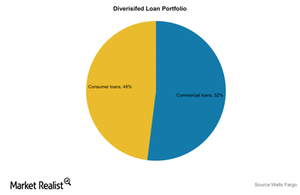Wells Fargo Benefits from a Solid Business Model
Wells Fargo (WFC) has been considered the strongest and most steady among the “too big to fail” banks in the United States for years.
July 1 2016, Updated 8:55 a.m. ET

Wells Fargo’s business model
Wells Fargo (WFC) is the strongest among the large banks (IYF) in the United States. It benefits from a diversified business mix, an experienced management team, and a large deposit base that makes it the most profitable among its peers.
Wells Fargo has a balanced business model based on three pillars:
- diversified loan portfolio
- balanced spread and fee income
- diversified fee generation
Diversified loan portfolio
Wells Fargo has a well-diversified loan portfolio. The company has a healthy split between commercial and consumer loans. Its bedrock foundation is its mortgage portfolio. Although it has cut back on mortgage lending in the last few years due to low interest rates, this is still its strongest growth area.
In 1Q16, Wells Fargo had a loan portfolio worth $947 billion, the largest among its peers. By comparison, Bank of America (BAC) had a loan portfolio of $901 billion, while JPMorgan Chase (JPM) and Citigroup (C) had loan portfolios of $847 billion and $619 billion, respectively.
Diversified fee generation
Wells Fargo has a well-diversified revenue stream for fee-based income, ranging from broker advisory, trust and investment management, and investment banking income.
Additionally, its successful cross-selling strategy has helped it gain a competitive advantage, as well as drive its revenues and expense synergies. Wells Fargo leverages its customer-centric business by maximizing the cross-selling of its products.
Low risk, stable business model
Wells Fargo (WFC) has been considered the strongest and most steady among the “too big to fail” banks in the United States for years. This is due to its relatively low risk exposure to global events and prudent management.
Further, Wells Fargo has relatively smaller exposure to risky businesses such as investment banking and trading, unlike its peers JPMorgan Chase (JPM) and Goldman Sachs (GS). In 2015, Wells Fargo’s trading assets accounted for 4.3% of its total assets, compared to 14.6% for JPMorgan Chase and 14.4% for Citigroup.
